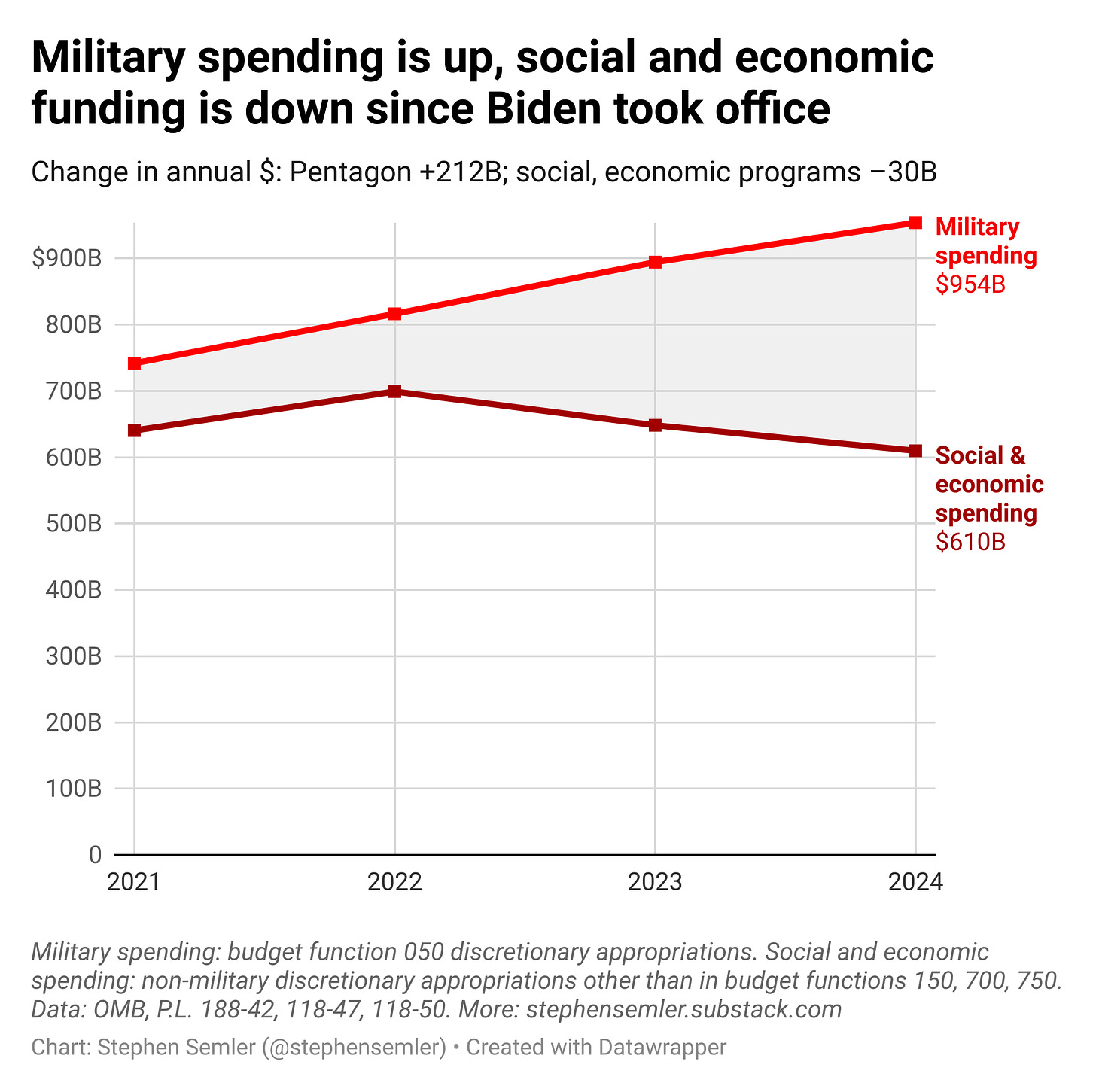Military spending is up, social and economic funding is down since FY2021
Polygraph | Newsletter n°257 | 10 July 2024
*My latest in Jacobin: https://jacobin.com/2024/07/biden-inflation-food-trump-campaign
Situation
Speaking at a think tank event this week, House Speaker Mike Johnson (R-LA) previewed what would happen to the federal budget under a Republican White House and Congress:
“To meet our defense needs, Congress has to work to grow our economy and significantly reduce our overall spending. I can promise you that come 2025, spending reform will be a top priority for our new Republican majority…Congress has to prioritize the truly essential needs of our nation and our national security has to be at the top of that list.”
Johnson’s quote is summarized perfectly here:
^Source: https://x.com/MollyJongFast/status/1810394761536360958
The problem is bipartisan
As someone who cares deeply/never shuts up about federal budget politics, I’m glad that tweet is getting good traction, but cutting social spending and increasing military spending isn’t just a future possibility. What Jong-Fast warns will happen under Trump is already happening under Biden.
For the chart below,1 I looked at the annual discretionary budgets enacted for fiscal years 2021 to 2024. Since Biden took office, the military budget has increased (in nominal terms) by more than $212 billion, while funding for social and economic programs has shrunk by more than $30 billion. His first budget (for FY2022) increased funding for both, but the next two pushed funding (way) higher for the Pentagon and lower for almost everything else.
Blame Republicans if you want, but save some for the president and congressional Democrats. Biden rebranded as a deficit hawk after the FY2022 budget process, the FY2023 spending bill was passed under the Democratic trifecta, and the FY2024 appropriations bills were enacted with overwhelming Democratic support at Biden’s urging. We’ve got a bipartisan problem here.
^Alt text for screen readers: Military spending is up, social and economic funding is down since Biden took office. Change in annual funding: Pentagon, plus $212 billion; social and economic programs, minus $30 billion. This chart shows two lines moving opposite directions since 2022. Since then, military spending has increased to $954 billion. Social and economic spending has decreased to $610 billion. Military spending refers to budget function 050 discretionary appropriations. Social and economic spending refers to non-military discretionary appropriations other than in budget functions 150, 700, and 750. Data: OMB, Public Laws 118-42, 118-47, 118-50.
SPECIAL THANKS TO: Alan F., Andrew R., Bart B., BeepBoop, Bill S., Byron D., Chris G., David S.,* David V.,* Francis M., Irene B., Gary W., George C., Jcowens004, Jerry S., John A., Joseph B., Kheng L., Linda B., Lora L., Marie R., Mark G., Matthew H.,* Megan., Meghan W., Nick B., Omar D.,* Peter M., Philip L., Rosemary K., Silversurfer7, Springseep, Theresa A., Themadking724, Tim C., Tony L., Tony T.
* = founding member
-Stephen (Follow me on Instagram, Twitter, and Bluesky)
After I published this note, I noticed a typo in the bottom section of the chart. After “Data” the first public law (P.L.) cited should read 118-42, not 188-42. Sorry about that.






I very much appreciate your reporting but when reporting spending on the military would it not be appropriate to also include the legacy costs of our past wars, I.e. spending on veterans care and benefits? That would easily push our annual military spending well past the $1 trillion mark. In addition to this, one might also want to include the additional costs of interest on the debt, since much (if not all) of our annual deficit spending is due to our bloated military spending.